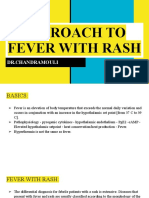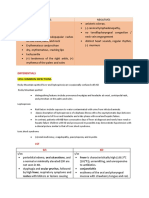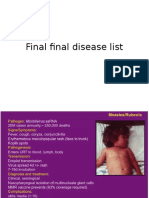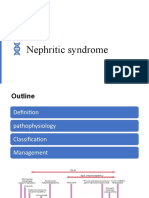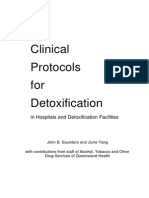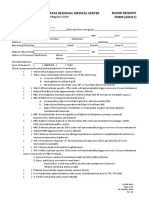0 ratings0% found this document useful (0 votes)
85 viewsDemam Ruam: Della Rizki Anggilia 18105
Demam Ruam: Della Rizki Anggilia 18105
Uploaded by
Della Rizki AnggiliaThis document describes the case of a 4-month-old male infant presenting with cough and runny nose who was admitted to the hospital. On examination, the infant was found to have rapid breathing, wheezing sounds, intermittent breathing interruptions, and a fever. A rash was observed over the entire body. The infant was diagnosed with lower respiratory tract infection and exanthem subitum (roseola). Treatment included bronchodilators, paracetamol for fever relief, and saline nebulization. The document then provides an overview of the diagnostic approach and characteristics of different types of skin rashes commonly seen in pediatric patients, including maculopapular, vesicular, and erythematous rashes
Copyright:
© All Rights Reserved
Available Formats
Download as PPTX, PDF, TXT or read online from Scribd
Demam Ruam: Della Rizki Anggilia 18105
Demam Ruam: Della Rizki Anggilia 18105
Uploaded by
Della Rizki Anggilia0 ratings0% found this document useful (0 votes)
85 views40 pagesThis document describes the case of a 4-month-old male infant presenting with cough and runny nose who was admitted to the hospital. On examination, the infant was found to have rapid breathing, wheezing sounds, intermittent breathing interruptions, and a fever. A rash was observed over the entire body. The infant was diagnosed with lower respiratory tract infection and exanthem subitum (roseola). Treatment included bronchodilators, paracetamol for fever relief, and saline nebulization. The document then provides an overview of the diagnostic approach and characteristics of different types of skin rashes commonly seen in pediatric patients, including maculopapular, vesicular, and erythematous rashes
Original Description:
materi kuliah demam ruam
Original Title
Demam Ruam
Copyright
© © All Rights Reserved
Available Formats
PPTX, PDF, TXT or read online from Scribd
Share this document
Did you find this document useful?
Is this content inappropriate?
This document describes the case of a 4-month-old male infant presenting with cough and runny nose who was admitted to the hospital. On examination, the infant was found to have rapid breathing, wheezing sounds, intermittent breathing interruptions, and a fever. A rash was observed over the entire body. The infant was diagnosed with lower respiratory tract infection and exanthem subitum (roseola). Treatment included bronchodilators, paracetamol for fever relief, and saline nebulization. The document then provides an overview of the diagnostic approach and characteristics of different types of skin rashes commonly seen in pediatric patients, including maculopapular, vesicular, and erythematous rashes
Copyright:
© All Rights Reserved
Available Formats
Download as PPTX, PDF, TXT or read online from Scribd
Download as pptx, pdf, or txt
0 ratings0% found this document useful (0 votes)
85 views40 pagesDemam Ruam: Della Rizki Anggilia 18105
Demam Ruam: Della Rizki Anggilia 18105
Uploaded by
Della Rizki AnggiliaThis document describes the case of a 4-month-old male infant presenting with cough and runny nose who was admitted to the hospital. On examination, the infant was found to have rapid breathing, wheezing sounds, intermittent breathing interruptions, and a fever. A rash was observed over the entire body. The infant was diagnosed with lower respiratory tract infection and exanthem subitum (roseola). Treatment included bronchodilators, paracetamol for fever relief, and saline nebulization. The document then provides an overview of the diagnostic approach and characteristics of different types of skin rashes commonly seen in pediatric patients, including maculopapular, vesicular, and erythematous rashes
Copyright:
© All Rights Reserved
Available Formats
Download as PPTX, PDF, TXT or read online from Scribd
Download as pptx, pdf, or txt
You are on page 1of 40
DEMAM RUAM
Della Rizki Anggilia
18105
IDENTITAS
• Nama : An. RC
• Jenis Kelamin : Laki-laki
• Tanggal Lahir : 2 Januari 2019
• Usia : 4 bulan 17 hari
• Alamat : Patikraja
• Masuk RS : 16 Mei 2019
Keluhan Utama
• Batuk pilek
Assessment Awal Rawat Inap
• Anamnesis:
Keluhan utama: batuk dan pilek
3HSMRS anak nafas cepat, suara nafas grok-grok, saat menetek sering
terputus, demam namun tidak tahu suhunya dan lebih rewel dari
biasanya. 2HMRS ibu membawa ke puskesmas lalu mendapat
paracetamol, anak masih demam suhu 38 derajat, batuk berdahak dan
pilek. Setiap batuk anak sering muntah lendir. HMRS anak sudah tidak
demam namun muncul ruam di seluruh tubuh, tidak diketahui lokasi
awal ruamnya. Terakhir minum paracetamol malam sebelum masuk
rumah sakit.
Pemeriksaan Fisik
Kepala: CA-/-, SI -/-
• Keadaan umum: compos •
Leher: limfonodi tidak teraba
mentis, tampak sesak •
• Thorax: simetris, retraksi (-)
• Tanda Vital • Cor: S1 tunggal, S2 split tak konstan
N : 120x/menit • Pulmo: vesikuler (+), wheezing -/-,
ronkhi (+)
RR : 40x/menit • Abdomen: BU (+) normal, timpani,
supel, hepar dan lien tidak teraba
S : 37,6 0C
• Ekstrimitas: akral hangat, nadi kuat,
SpO2: 98% WPK <2 detik
Integumen : maculopapular
BB: 6,9 kg
•
hiperemis, multiple, terserbar di
wajah, dada, perut dan punggung,
batas tidak tegas, konsistensi seperti
kulit
Assessment
• ISPA
• Exanthema subitum
Plan
• Salbutamol syrup 3x ½ cth
• Paracetamol drops 0.7 cc per 4-6 jam jika demam (dilanjutkan)
• Nebu NaCl 0.9% extra
Introduction
• One of reason parent’s come to hospital
• Non-specific finding, classified based on morphology into
maculopapular rash, generalized diffuse erythema, vesicular,
pustular, nodular, petechial, purpuric, based on distribution into
systemic or localized; symmetric or asymmetric; based on etiology
infectious and non-infectious skin rashes
Diagnostic approach
• History taken: recent travel, contact with animals, medications,
exposure to forest and other natural environment, time of onset,
morphological patterns, seasonal occurrence, etc.
• Knowledge about morphologies, historical data combined with
selective laboratory testing should lead to appropriate
management
• Most of fever with rash in children is caused by viral (self-limited
disease)
• Lab: reactive lymphocytosis and eosinophilia suggest viral and
hypersensitivity reaction respectively.
Maculopapular Rashes
• Most common type of viral infection
• Measles rash (morbili/rubeola): Morbillivirus, rash starts from behind ears
and progresses to the face, followed by neck, torso, extremities over 2-3
days, fever disappears when rash stops evolving. Macular followed by
papular and gradually develops into morbilliform. Rash start to disappear
from face and residual brown skin pigmentation may appear in areas
where rash has faded. Koplik spot (enanthem) appear either 12 h before or
within 24 h of rash appearance.
• Rubella (german measles): progressive from face to body, complete
within hours (much faster than in measles), lighter color, rash fades within
2-4 days, no residual skin pigmentation after fading of rash, can be
prevented by immunization. Maternal infection can cause rubella
congenital.
• Exanthema subitum (roseola, three day fever, 6th disease): HHV-6, fever
lasts for about 3 days, rash appears as soon as fever ends, then spread
to neck, face and extrimities within 24 h and disappeared within 1-2
days, rash usually light rose in color
• Erythema infectiosum (fifth disease): caused by human parvovirus B19,
“slapped cheek”, evolves to a papular rash after macular rash at the
margins of extremities and on the buttocks, start to fade from middle of
the 6th day and disappear on 7th-9th day after first appearance (however
sometimes may recur after few weeks, this usually occur in school-aged
children unlike measles, rubella and roseola.
• Papular-purpuric gloves and socks syndrome (PGSS): caused by
parvovirus B19, may developed by cotrimoxazole antibiotic, skin lesion
develop after clearance of viremia and presence of rising antibody
titers. Usually resolves in 1-2 weeks without any known late sequel
• Pityriasis rosea : acute self-limited disorder, usually in spring and
autumn (seasonal clustering), no definite association of a known
pathogenic virus (suggest HHV-6 and HHV-7). Skin lesion consists of
discrete oval salmon-colored papules and macules, begins with single
herald patch, a week or more before other smaller lesions.
• Unilateral laterothoracic exanthem (asymmetric periflexural
exanthema of childhood) : has erythematous macules or papules that
form morbilliform, scarlatiniform, or eczematous patterns which
begins unilaterally in the axilla or groin, spreads centrifugally, and
usually resolves spontaneously by 4 weeks. The causative agent is
unknown, usually occur during winter and spring. Concomitant
symptoms are fever, sore throat, conjunctivitis, rhinopharyngitis or
diarrhea.
• Eruptive pseudoangiomatosis: small erythematous papules with central
pinpoint vascular supply and surrounding avascular halo. Direct
pressure resulted in complete blanching, and lesions were transient.
May be associated by viral agents, usually self limited.
• Scarlet fever: caused by erythrogenic toxin of Streptococcus pyogens
at the onset of disease. After prodromal symptoms of pharyngitis for
2-3 days, a minute papular rash starts in the axillary region and
inguinal area, and proceeds around the neck and the back, ultimately
spreading to the entire body and shows desquamation one week after
onset, persist for several weeks. In scarlet fever, there are no rashes or
clear findings of upper respiratory inflammation unlike measles and
rubella except area around mouth becomes pale and both cheeks are
red. There is also pastia lines: linear petechial hemorrhages in which
erythema does not disappear when the axillary region, inguinal area,
and antecubital fossa are compressed.
Vesicular rash
• Chicken pox (varicella): rashes spread from the chest to the periphery, and
then to the entire body over the course of about 3 days. Rash patterns
involve the initial appearance of vesicles in a teardrop shape, followed by
simultaneous occurrence of papular and macular rashes with crusting.
These vesicular rashes mostly appear concentrated on the torso, the
extremities, and the head, including the scalp, and can occur on the oral
mucosa accompanied by severe pruritus, and last for 5-6 days; during this
time, the disease remains contagious until crusting is complete, and it is
necessary to isolate patient.
• Herpes zoster: secondary infection by varicella zoster virus, not
common in children. Local rash due to invasion of the virus into local
peripheral nerves. Rarely cause severe pain unlike in adult. If there is
invasion into trigeminal or auditory nerve, can be accompanied by
dizziness or hearing loss. Persist for 5 days or longer.
• Hand-foot-mouth disease: Papular follicles 2-10 mm in size are
accompanied by pain and fever, gastrointestinal symptoms, and local
lymph node enlargement. The lesions mostly occur on the oral
mucosa, the hands, the feet, and buttocks. In rare cases, they might
appear in the nostrils, genitalia, and conjunctiva. This disease can be
spread through direct contact. However, if hand-foot-mouth disease
due to enterovirus type 71 spreads rapidly, paralytic neurological
complications due to encephalitis and spondylitis can appear around
the time that the rash subsides.
• Fungal dermatologic infection: commonly caused by Candida
albicans. Mostly occurs in inguinal and neck which are moist and
creased, it is hard to differentiate from diaper rash and infantile
eczema. However, since the center of the skin lesion is paler than
normal skin, and the outer parts are clearly raised, and as regions of
occurrence gradually spread.
Erythematous rashes
• Urticarial rashes
- History taking: exposure to antibiotics for differentiation between
infectious and non infectious causes.
- Consideration: allergic response to administration of antibiotics or
interaction with sources of infection with antibiotics (mononucleosis
due to EBV)
- Example of bacterial disease with urticarial rash is mycoplasma
infection (appear during treatment of fever respiratiory infection)
- Nonbacterial infectious: lyme disease, enteroviral infection,
adenoviral infection, EBV, hepatitis viral, allergy, etc.
TERIMA KASIH
Mohon asupan
You might also like
- Case Presentation - ScabiesDocument29 pagesCase Presentation - Scabiesiamboredtired67% (3)
- Measles: Wilbert H. Mason Nelson's Textbook of Pediatrics 20th EditionDocument30 pagesMeasles: Wilbert H. Mason Nelson's Textbook of Pediatrics 20th EditionEarl Mel Dustin LaoNo ratings yet
- Psychia AnamnesisDocument9 pagesPsychia AnamnesisKen Harry MirafuentesNo ratings yet
- Fever and RashDocument120 pagesFever and RashsamaNo ratings yet
- 10 - Derma-RashesDocument49 pages10 - Derma-Rashesraja iramNo ratings yet
- Fever and Rash: Djatnika SetiabudiDocument50 pagesFever and Rash: Djatnika SetiabudiNur OctavianiNo ratings yet
- Dermatology Videos by DR RihamDocument31 pagesDermatology Videos by DR Rihamengr_shazzNo ratings yet
- Fever With RashDocument42 pagesFever With RashMeena ViswaNo ratings yet
- DDs of Fever With RashDocument18 pagesDDs of Fever With RashEBNo ratings yet
- Infectious DiseaseDocument120 pagesInfectious Diseaseapi-3722655100% (2)
- Fever and Rash Mar 2016Document30 pagesFever and Rash Mar 2016almiraerickaiNo ratings yet
- Disturbances in Inflammatory and ImmunologyDocument89 pagesDisturbances in Inflammatory and ImmunologyAubrey RafadaNo ratings yet
- Viral Exanthems: Sahara Tuazan AbonawasDocument75 pagesViral Exanthems: Sahara Tuazan AbonawasMarlon Cenabre Turaja100% (1)
- İSÜ Case1-Child With Red EruptionDocument44 pagesİSÜ Case1-Child With Red EruptionyasminsomaatefNo ratings yet
- Case - LeptospirosisDocument39 pagesCase - LeptospirosisKimm Delos ReyesNo ratings yet
- Fever and Rash - StudentsDocument117 pagesFever and Rash - StudentsAishath Mizna MOOSA 17-2-00902No ratings yet
- Infectious Diseases That Evolve With ExanthemaDocument64 pagesInfectious Diseases That Evolve With ExanthemaBeni KelnerNo ratings yet
- Herpes Simplex: Bing-Rong ZHOUDocument24 pagesHerpes Simplex: Bing-Rong ZHOUMichael Jansen SulaimanNo ratings yet
- Bacterial Infections: Infections Caused by Gram Positive OrganismsDocument81 pagesBacterial Infections: Infections Caused by Gram Positive OrganismsJamalul AdilNo ratings yet
- MeaslesDocument23 pagesMeaslesadwait marhattaNo ratings yet
- Approach To Fever With RashDocument35 pagesApproach To Fever With RashSenthilnathan ANo ratings yet
- Viral InfectionDocument36 pagesViral InfectionHani El-asferNo ratings yet
- Fever and RashDocument14 pagesFever and RashSelvi Puspa SariNo ratings yet
- Reactive Erythemas and VasculitisDocument51 pagesReactive Erythemas and VasculitisMoayad NawaflehNo ratings yet
- Overview of Mucocutaneous Symptom ComplexDocument5 pagesOverview of Mucocutaneous Symptom ComplexDaphne Jo ValmonteNo ratings yet
- G.medicine (Infectious Diseases)Document47 pagesG.medicine (Infectious Diseases)Abdul Latif SoomroNo ratings yet
- Roseola Infantum (Exanthema Subitum)Document8 pagesRoseola Infantum (Exanthema Subitum)hananNo ratings yet
- Mumps - Nguyen Thi Ngoc ThamDocument32 pagesMumps - Nguyen Thi Ngoc Thamnguyenthingoctham1208No ratings yet
- 19 - VIRAL INFECTIONS - FinalDocument55 pages19 - VIRAL INFECTIONS - FinalMohammed GamalNo ratings yet
- Amal LBM 1Document16 pagesAmal LBM 1hening ciptiany pertiwyNo ratings yet
- PEDIA Viral ExanthemsDocument68 pagesPEDIA Viral ExanthemsRice CookerNo ratings yet
- Https://ar - scribd.com/document/391648283/OET Future Land Full Book Final Edition July 2018Document52 pagesHttps://ar - scribd.com/document/391648283/OET Future Land Full Book Final Edition July 2018Qutaiba ShdaifatNo ratings yet
- Espiratory Infections BitseatDocument90 pagesEspiratory Infections BitseatAhmed KitawNo ratings yet
- Derm PathologyDocument21 pagesDerm PathologyMaria GeorgeNo ratings yet
- ExanthemsDocument38 pagesExanthemswilliamwlinNo ratings yet
- The Acutely Ill Patient With Fever and Rash Department of Microbiology Micro II-643 Infectious Diseases Victoria Michelen, MDDocument49 pagesThe Acutely Ill Patient With Fever and Rash Department of Microbiology Micro II-643 Infectious Diseases Victoria Michelen, MDFelito SifonteNo ratings yet
- Case Presentation: Pediatrics RotationDocument25 pagesCase Presentation: Pediatrics RotationklipordNo ratings yet
- Clinical Infectious Disease Nplex ReviewDocument64 pagesClinical Infectious Disease Nplex ReviewValeria AcevedoNo ratings yet
- K22-Roseola InfantumDocument8 pagesK22-Roseola InfantumAryo Handoko Sitorus100% (1)
- INFECTIOUS DISEASESDocument199 pagesINFECTIOUS DISEASESBurak ElkanNo ratings yet
- Viral Exanthem (Main)Document94 pagesViral Exanthem (Main)Starlet Rhonadez Bito-onon OrielNo ratings yet
- Brain InfectionDocument61 pagesBrain Infectionmanisha paikarayNo ratings yet
- Viral Infection PDFDocument252 pagesViral Infection PDFMark Samuel TanchocoNo ratings yet
- Enteroviral InfectionsDocument32 pagesEnteroviral InfectionsTarik PlojovicNo ratings yet
- Scarlet FeverDocument6 pagesScarlet FeverDimasHariAgungNo ratings yet
- Morbili: Oleh: Rostika Ayu Fhany EL SharaDocument30 pagesMorbili: Oleh: Rostika Ayu Fhany EL Sharadian febriana yasmarNo ratings yet
- Child With Rashes: Faris Mohd Nasir 1314597Document34 pagesChild With Rashes: Faris Mohd Nasir 1314597Faris Mohd NasirNo ratings yet
- Differentials: Less Common InfectionsDocument6 pagesDifferentials: Less Common InfectionsTaeyomiNo ratings yet
- Viral Infections Part 1 by Nicolle Ann Pancho (Pediatrics Rotation)Document67 pagesViral Infections Part 1 by Nicolle Ann Pancho (Pediatrics Rotation)Nicolle PanchoNo ratings yet
- MeaslesDocument20 pagesMeaslesTinde KumarNo ratings yet
- Roseola Infantum : Exanthema SubitumDocument8 pagesRoseola Infantum : Exanthema SubitumDilan RasyidNo ratings yet
- Viral Skin DiseaseDocument27 pagesViral Skin DiseaseRabina PantaNo ratings yet
- Sexually Transmitted DiseasesDocument174 pagesSexually Transmitted Diseasesfroizki100% (2)
- PediatricsDocument58 pagesPediatricsbashir019No ratings yet
- Cme 2012 WarrenDocument69 pagesCme 2012 WarrenMateen ShukriNo ratings yet
- Shanz - Pedia Ii 2.02 NewDocument7 pagesShanz - Pedia Ii 2.02 NewPetrina XuNo ratings yet
- Communicable Diseases PowerPoint - StudentDocument15 pagesCommunicable Diseases PowerPoint - StudentCruz YrNo ratings yet
- Fever and Rash by DR Djatnika (2 September 2014)Document67 pagesFever and Rash by DR Djatnika (2 September 2014)DimasHariAgungNo ratings yet
- Micro Bio Disease ListDocument168 pagesMicro Bio Disease Listspiff spacemanNo ratings yet
- The Flu: A Guide for Prevention and TreatmentFrom EverandThe Flu: A Guide for Prevention and TreatmentRating: 5 out of 5 stars5/5 (1)
- 1st Ayurveda Today Conference & Arogya ExpoDocument14 pages1st Ayurveda Today Conference & Arogya ExpoSatish ValekarNo ratings yet
- The Age of Re Enchantment 2.06.23Document119 pagesThe Age of Re Enchantment 2.06.23Anahí CamposNo ratings yet
- Psychiatric Cultures Compared Psychiatry And: Mental Health Care in The Twentieth CenturyDocument457 pagesPsychiatric Cultures Compared Psychiatry And: Mental Health Care in The Twentieth CenturySandra LanguréNo ratings yet
- Ch. 24 Professional Idenity and ImageDocument6 pagesCh. 24 Professional Idenity and Imagehyerimyun0331No ratings yet
- UNICEF Supply Annual Report 2010 WebDocument68 pagesUNICEF Supply Annual Report 2010 WebU.S. Fund for UNICEF100% (3)
- Ethics PosterDocument1 pageEthics Posterndrmxg9gbdNo ratings yet
- DiagnosisbyYijing Version 30.06.2015Document4 pagesDiagnosisbyYijing Version 30.06.2015Carlos DrachenbergNo ratings yet
- Data Kasus TB RS Hikmah MasambaDocument2 pagesData Kasus TB RS Hikmah MasambaHikmah GroupNo ratings yet
- Session 3 - Lesson 15 - Handling Stress in GroupsDocument28 pagesSession 3 - Lesson 15 - Handling Stress in GroupsNam NguyễnNo ratings yet
- Nephritic SyndromeDocument23 pagesNephritic SyndromeLateefah TalalNo ratings yet
- Mature B Cell Lymphoma CLL PLL HCLDocument4 pagesMature B Cell Lymphoma CLL PLL HCLlai cruzNo ratings yet
- Benefits of ApplesDocument12 pagesBenefits of ApplesAbdel AhmedNo ratings yet
- Enc 1102 Research ProposalDocument4 pagesEnc 1102 Research Proposalapi-317153884No ratings yet
- AB OSCE Answer Tips SlideDocument2 pagesAB OSCE Answer Tips SlideAlwaallh MohammedNo ratings yet
- Module 11 EbookDocument106 pagesModule 11 EbookJulienne VinaraoNo ratings yet
- Practice Test 2: ListeningDocument6 pagesPractice Test 2: ListeningrhusheinNo ratings yet
- 8th Grade Restaurant Creation ProjectDocument1 page8th Grade Restaurant Creation Projectapi-263456844No ratings yet
- Get Davidson’s Principles and Practice of Medicine, 24th Edition Stuart Ralston PDF ebook with Full Chapters NowDocument40 pagesGet Davidson’s Principles and Practice of Medicine, 24th Edition Stuart Ralston PDF ebook with Full Chapters Nowneykanevdin75100% (2)
- Research ProposalDocument9 pagesResearch ProposalKaren Claire RussNo ratings yet
- Health Effects of Overweight and Obesity in 195 Countries Over 2 2017Document15 pagesHealth Effects of Overweight and Obesity in 195 Countries Over 2 2017Renald Umbu Deta DapawandoNo ratings yet
- Clinical Protocol DetoxificationDocument157 pagesClinical Protocol DetoxificationWilliam Aditya100% (4)
- Blood Request Form (Adult)Document2 pagesBlood Request Form (Adult)peanutbutter oh80% (5)
- kiểm tra TACN2 chiều thứ 3Document8 pageskiểm tra TACN2 chiều thứ 3nguyetram1307ptNo ratings yet
- Lemone CRS Units 1 15Document351 pagesLemone CRS Units 1 15Anmar MarNo ratings yet
- 0121 Letter Directing Employee To Undertake Fitness Work AssessmentDocument2 pages0121 Letter Directing Employee To Undertake Fitness Work AssessmentRobin james PardilloNo ratings yet
- OUA Memo 0821135 Request For Messages and Appearance in The OK Sa DepEd One Health Week Events 2021-08-17 UnlockedDocument16 pagesOUA Memo 0821135 Request For Messages and Appearance in The OK Sa DepEd One Health Week Events 2021-08-17 UnlockedPrecious BalgunaNo ratings yet
- Residential Design Guide: Places To LiveDocument82 pagesResidential Design Guide: Places To Liveshaimaa08No ratings yet
- Nursing Care of The Dead ChildDocument20 pagesNursing Care of The Dead ChildHeba_Al_KhozaeNo ratings yet
- MSDS ChlorguardDocument8 pagesMSDS ChlorguardPutri Indah LestariNo ratings yet




















